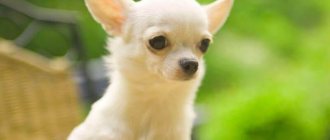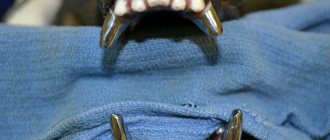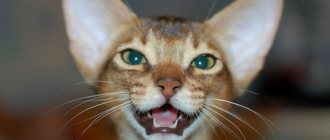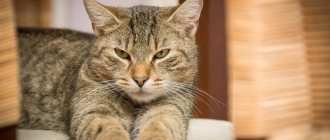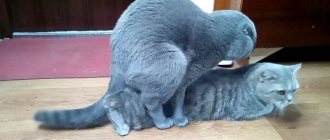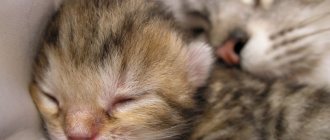Kittens, like other pets, are born without teeth. As kittens grow older, they develop baby teeth one after another, which are eventually replaced by permanent teeth. The process of the appearance and change of teeth usually goes unnoticed for owners, as it usually takes place without any complications.
Knowledge of the process of changing baby teeth to permanent teeth will allow kitten owners to promptly notice and eliminate possible problems in the kittens’ oral cavity.
Formation of a cat's dental bite.
A kitten's milk teeth begin to erupt from the 2nd week of life and finish erupting by 6-8 weeks of age. In total, by the age of 2 months, a kitten has 26 milk teeth, which form the cat’s bite.
The order of eruption of baby teeth in a cat.
The kitten's incisors are the first to erupt at 2-4 weeks of age. At 3-4 weeks of age, fangs appear. Premolars appear in a kitten at the age of 6-8 weeks.
A kitten's emerging baby teeth are thinner than their permanent teeth. The baby teeth will serve the kitten for several months. If the cat has enough milk, and the kittens are given balanced supplementary feeding in a timely manner, there is no lag in weight gain and development, the replacement of milk teeth with permanent teeth will begin at the age of 3–4 months.
How do baby teeth change to permanent teeth?.
The replacement of baby teeth with permanent teeth in a kitten begins at 3-5 months of age and ends at 7-8 months, when 30 permanent teeth form a permanent molar bite. Constant contact and mechanical irritation causes destruction of the roots of baby teeth, which stimulates loosening and their loss.
The process of replacing baby teeth with permanent teeth is usually painless and goes unnoticed for cat owners.
The resulting permanent dentition in a cat is represented by:
- 12 incisors (6 incisors each on the lower and upper jaws).
- 4 fangs (two on each jaw, running along the edges of the incisors).
- 10 premolars (start behind the canines, with 6 premolars in the upper jaw and 4 premolars in the lower jaw).
- 4 molars (2 on each jaw). These 4 molars in the cat are missing in the primary dentition.
The order of replacement of baby teeth with permanent teeth.
The replacement of milk teeth with permanent ones in a cat occurs in the same order as the appearance of milk teeth.
- First, at 4-5 months, the incisors are replaced.
- Then, at 4-6 months, the fangs are replaced.
- At 5-6 months, the premolars are replaced.
- At the end of the 6th month, molars grow.
Do kittens' teeth change?
All cats are born toothless. This feature prevents damage to the nipples when feeding with breast milk. The first teeth erupt at 3-4 weeks of life. At the same time, babies are introduced to complementary foods. Small cats rarely leave their mother cat, so they do not try to chew furniture or other interior items.
Kittens' milk teeth are fully grown by 2 months. Their number is 26 pieces: 12 at the bottom and 14 at the top. The first to appear are the incisors, then the canines, and the last to emerge are the premolars. Subsequent changes in the oral cavity occur at four months of age, when the molars begin to emerge.
At what age does replacement occur?
Already from the age of three months, the baby's milky bone processes in the mouth begin to fall out.
When the kitten is 3-4 months old, the baby teeth fall out and change. Permanent teeth are cut gradually - first, new incisors appear, then fangs, small and large on the sides. Maximum up to 8 months. In life, they are all located in their places, and consist of 14 lower and 16 upper. If the process itself is asymptomatic, then it can be noticed by the pet’s behavior. At this time, cats begin to chew everything, they often salivate heavily, and a smell appears from the mouth, which is absolutely natural.
The difference between baby teeth and molars
The first difference is quantity. There are 4 more radicals, that is, the total number is no longer 26, but 30. New samples erupt a little later, prolonging the discomfort in the gums.
In addition to quantity, changes affect shape and appearance. Kittens' milk teeth get their name from their snow-white enamel. Their color is similar to milk, and they themselves have a surprisingly straight shape with pointed, needle-like tips. With age, the teeth bend, become denser, turn yellow or even blacken, becoming overgrown with plaque and tartar.
On the inside of baby fangs you can find small growths that resemble a miniature version of them. After the change they fall out and never appear again.
When do kittens change teeth: timing for different breeds
In most cases, the replacement of baby teeth in kittens begins at 3-5 months and ends at 7-8 months. This time is enough for the final formation of the bite characteristic of the breed.
When buying a furry family member, ask about its breed characteristics. Not all representatives fit into the average standards. Owners should know about this in advance in order to contact a veterinarian in time or, conversely, not worry about trifles. They have these features:
- Siamese and Thais
. Rapid development is normal for these cats, so at six months they can show off new molars. Only the fangs, distinguished by their impressive length and thickness, live their own lives. Baby teeth often fall out before the molars erupt. The pet will have to live without solid food for some time.
- Maine Coons
. These big guys are classified as kittens up to fifteen months of age. They go through the shift later, so wait patiently for the natives to appear before the year begins. Remember that this breed is characterized by a violent temperament: due to aching pain and itching, the pet will chew everything it sees on its way.
- Siberians
. For Siberian cats, everything is strictly on schedule. A shining set of 26 pieces appears at 2 months, and after another 2 months it changes to a permanent one within 2-3 months. A delay of a month is typical for large males.
- Scots and British
. The molars of these cats begin to erupt at four months of age, even before the milk teeth fall out. Most often, the problem occurs with large fangs that are firmly embedded in the sockets. If the period recommended for replacement has passed, and the baby teeth are still in place, contact the veterinary clinic. You should also be wary of soft tissue inflammation, which can lead to infection by pathogenic microorganisms.
- Sphinxes
. Baby teeth don't fall out until the molars appear, so the whole process can take up to a year. This is due to slow growing fangs.
- Bengals
. Molars should appear no later than 6 months. Otherwise, it is better to show the baby to the veterinarian. The delay may be due to a lack of vitamins, which will affect the quality of the coat. Accelerated turnover, characteristic of Asians, is possible, but rare.
By 8 months, most pets acquire a standard set of:
- 12 incisors responsible for biting food;
- 4 fangs, necessary for capturing and tearing prey, as well as defense against enemies;
- 10 premolars, used for chewing food;
- 4 molars associated with wisdom.
Molars are a feature of adult animals. The bite is formed from the center to the edge of the mouth.
How to tell if a cat's teeth are changing
In most cases, changing teeth in kittens is painless. The process is often accompanied by increased salivation and the appearance of bad breath, which goes away on its own within a month. You can recognize a new stage of growing up by reddened gums and some behavioral changes.
Red gums
When a toothache occurs, the baby may refuse to eat, but usually the owner notices changes in the tooth that has already fallen out. If the gums have acquired a bright red tint and your pet has not eaten for more than a day, consult a doctor.
Order of loss of canines, incisors and molars
Molar incisors, canines, premolars and molars, formed deep in the gums, grow and thin out the milk roots. Over time, their predecessors become loose and fall out. Finding a dropped sample is problematic, since pets often swallow it along with food.
The order of appearance and loss is always the same. At 3-4 months the incisors fall out, at 4-5 months the canines fall out, followed by the premolars. The molars are a little late. They are formed only by 7-8 months. As a result, the matured pet can boast of a “combat” set of 30 pieces: 14 on the bottom and 16 on top.
The site of appearance swells a little, but returns to normal within a couple of days after eruption. Also, immediately after prolapse, light bleeding is acceptable, lasting no more than 3 minutes.
Baby's behavior
A slight and short-term increase in temperature up to 39.5 °C is acceptable. Due to differences between internal and external temperatures, the pet will constantly look for any sources of heat: bury itself under a blanket or occupy the owner’s lap.
The process often coincides with puberty, so cats begin to mark their territory. Due to constant itching, the furry pet will begin to gnaw on any inedible objects and bite the owner’s fingers. He may also rub his face with his paws or on the edges of furniture.
If the kitten becomes aggressive and its temperature persists for more than 2 days, take it for examination. A swallowed tooth could get stuck inside the intestines and damage its walls.
Caring for a kitten during the period of teeth change
The period of changing teeth can really become a test for an inexperienced owner. However, it is necessary to understand that the animal is not sick, does not need to take medications and constant visits from veterinarians. Most often, for a cat, everything happens, if not unnoticed, then at least painlessly.
There is no need to allow the kitten to chew furniture, spoil things, and especially not to bite and scratch you. In the future, this habit could become a really serious problem. Changing teeth is a natural process for an animal; therefore, the initially established rules of behavior must be preserved.
However, the task of every responsible owner is to make this period easier for the animal, take care of proper nutrition, brushing teeth and the availability of special toys.
Special food
A kitten needs proper and complete nutrition . However, despite the abundance of food created specifically for the period of teeth change, the animal may react negatively to a sudden change in food. Therefore, you need to ensure that your pet has the necessary vitamins and supplements in its diet, thanks to which permanent teeth will grow strong.
There are nutritional principles that must be followed when a kitten’s teeth change:
- First of all, you need to avoid overly soft food: kittens can swallow lost teeth along with soft food, which can lead to damage to the esophagus. The food should be large and slightly rough. Regular dry food for kittens is ideal.
Dry food is the best option during teeth change
- Large pieces of meat (beef, turkey, chicken, rabbit) scalded or boiled, cut into small pieces, are also ideal for a kitten.
- You need to include cottage cheese and other fermented milk products that are rich in calcium in your diet.
- The kitten needs calcium and phosphorus; they can be given as supplements to the main diet. At the pet store you can find both drops and small tablets that can be added to food. Such supplements also contain a little analgesic so that the kitten does not experience severe pain.
- A maximum of twice a week, you can give your kitten low-fat boiled sea fish, for example, hake. However, you should not overuse fish, even though it is rich in phosphorus.
- Meat or fish should be given mixed with cereals: oatmeal, buckwheat or rice. It is also useful to add some vegetables, such as carrots, zucchini or pumpkin, both raw and boiled.
- The diet should also include sufficient amounts of vitamins A and D.
- The kitten will try to chew everything, including your things, so it’s worth purchasing special bones. They contain the necessary vitamin supplements, and in fact the kitten gets the opportunity not only to strengthen its teeth, but also the necessary amount of vitamins supplied with saliva.
Bones are an important part of the diet and serve to prevent the kitten from chewing your things.
Veterinarians advise not to mix natural food (meat, fish, vegetables, etc.) and dry food. If you switched your kitten to dry food at an early age, then you should stick to it. The fact is that these types of food are digested differently, and when mixed, the kitten may experience bloating or even colic.
When choosing a feeding method, you should consult a veterinarian: each pet is individual, many may not be suitable for dry or natural food
Vaccination during the period of teeth change
Very often, owners are faced with an important question: is it possible to get vaccinations or other vaccinations while changing teeth? Veterinarians speak out unequivocally - changing teeth is already a serious burden for a kitten. Against the backdrop of fever and pain, getting vaccinated can be dangerous. This not only adversely affects the kitten’s immune system, but also leads to stunted growth of the animal.
Vaccination during the period of teeth change is not recommended.
It is important to follow the vaccination schedule for your pets as prescribed by your doctor. The vaccination schedule is set individually, taking into account the age characteristics of the body and physiological state.
My kitten was scheduled for the first vaccination very late. This was due to the fact that he was found on the street and many tests had to be done to assess his health. The time for his vaccination was due to change his teeth, so it had to be postponed for a while (until the temperature passed and slight inflammation of the gums subsided).
Teeth cleaning
Many owners ignore brushing their teeth. However, constant oral care will help keep your animal's teeth strong. It is necessary to accustom your cat to brushing its teeth from the early months of life so that in the future it will adequately perceive this procedure. If the cat refuses to accept traditional brushing with a toothbrush or powder, pet stores sell special gels for disinfecting the oral cavity. You can combine them with special foods and vitamins that include coarse fibers. It is recommended to brush your teeth once every three to four weeks.
Brushing your teeth is an important procedure that your kitten needs to be accustomed to.
During the change of teeth, kittens' gums can become inflamed, so you need to purchase a gel that also contains an anesthetic and anti-inflammatory, which can greatly alleviate your pet's condition.
How to care for an animal
Don't worry about the health of your little pet. He will easily survive this stage with your help and support. Remember that this is a natural process, not a disease. Don't let your artistic pet outsmart you.
Follow the rules of your home, excluding damage to furniture and scratching your hands. Instead of senseless destruction, offer your baby a rubber toy or a cat teether with water inside. Pre-chill the device in the freezer. This will help relieve inflammation and reduce itching. Instead of punishing spoiled items, put them out of reach in advance. Pay special attention to wires that can shock your pet.
Don't forget to take care of oral hygiene and adjust feeding. For preventative purposes, take your baby for examination to a veterinary clinic every 2 months. This will help to detect any deviations that may occur in a timely manner.
Feeding
When dry feeding, focus on the animal’s well-being. For inflammation and sore gums, it is better to choose soft food, and for itching, hard granules.
At this time, the kitten needs a lot of phosphorus and calcium. And if in ready-made feed they are already present in the required dosage, then with natural feeding they will have to be obtained independently with the help of fermented milk products, veal, beef liver and sea fish.
If you already have a balanced natural diet, it is recommended to consult a veterinarian. Buying vitamin-mineral complexes on your own can lead to an overabundance of vitamins.
It is equally dangerous to try to mix two different types of feeding. Dry kibble and regular foods take different times to digest. Mixing them will lead to bloating and colic.
Oral hygiene
Cleaning the oral cavity is the basis of proper care. Cats do not like this procedure, so they are taught to use a toothbrush from early childhood. Brushing is done monthly using a small finger brush and veterinary toothpaste. During the procedure, move from top to bottom along the outside and then along the inside of the tooth.
As an alternative, you can use special cleaning gels. In addition to disinfection, they have an anti-inflammatory and analgesic effect.
Regular oral hygiene prevents the development of tartar, caries, stomatitis and other dental diseases.
It is also recommended to wipe the mucous membranes daily with a herbal decoction based on chamomile and sage until all teeth have been replaced. Before using it, apply a small amount to the animal's skin - this will help confirm or refute the possibility of an allergic reaction.
Symptoms
Vaccinations for kittens: what and when to do, at what age
It is not always possible to notice the process when kittens change teeth, since this usually happens painlessly without causing discomfort to the pet. The understanding that a kitten has lost a baby tooth comes when it is found in the apartment.
When a kitten is teething, he chews on everything.
However, the change of fangs in a kitten can be recognized by the following signs:
- unpleasant odor from the mouth, which disappears as soon as the last tooth erupts;
- increased salivation;
- swollen gums; if redness or bleeding is detected, it is recommended to consult a specialist to avoid chronic inflammation;
- a slight increase in temperature, during which the kitten tries to warm up in the owner’s arms or by hiding under a blanket;
- the pet tries to chew hard objects, in a similar way he tries to soothe the itching in the gums and push out a loose tooth;
- probability of territory marking in males;
- loss of appetite or complete refusal to eat for 1-2 days due to sore gums. To eliminate this symptom, it is recommended to replace your usual food with softer or finely chopped food with a high phosphorus content. The best options are industrial feed in liquid or canned form, fermented milk products;
- irritability, aggressiveness, decreased activity and prolonged sleep in a warm place.
Kittens often chew their owner's fingers
Note! Loss of a baby tooth can occur during eating, causing it to be swallowed with food. It is necessary to trace the exit of the swallowed tooth naturally. If this does not happen, it causes pain and discomfort to the pet, you should seek help from a veterinary clinic.
What to feed kittens during this period
There are often recommendations to switch to soft, crushed food during the period of replacing a kitten's fangs, which will avoid irritating the swollen gums and make the feeding process easier. Some veterinarians, on the contrary, believe that with soft food, the likelihood of eating a lost tooth increases. Experts recommend adding dry food to your pet’s diet, which will help reduce gum itching.
But this food is a must for kittens, since adult pieces are larger, denser and drier. For pets whose diet consists of homemade products, the best option would be chopped boiled chicken, turkey, fermented milk products, fresh carrots or cucumbers, and pieces of sea fish once a week. In addition, vitamin supplements in the form of drops will help enrich foods with the necessary phosphorus and calcium.
This is interesting: Photo of a white Maine Coon
Is it possible to get vaccinated at this time?
Breeders vaccinate kittens after the first eruption. The vaccinations given are recorded in the veterinary passport. After this, the babies are put up for sale, trying to give them to new families before the start of the next shift. This approach eliminates the coincidence of stress from moving and the decline in immunity that occurs when you lose your first teeth. These days, the pet is especially vulnerable to infections.
Weak immunity, possible fever and pain in the gums are not the best factors at the time of vaccination. Vaccination in this state may result in growth retardation or infection from the vaccine. To avoid trouble, veterinarians recommend waiting until you feel better. To this end, your pet's veterinarian should recommend an individual vaccination schedule.
Complications that require you to consult a veterinarian
To avoid complications, inspect your pet's mouth every few days. If he is lethargic, restless, constantly meows and refuses to eat for more than a day, make an appointment at a veterinary clinic for an examination. These symptoms often occur when there is severe inflammation.
Gingivitis or severe bleeding gums
Gingivitis, or inflammation of the gums, is the most common complication. When this problem occurs, the mucous membranes become bright red and become very swollen. The fur on the chest takes on a ruffled appearance due to excess saliva dripping from the mouth.
If severe bleeding gums and a pungent and disgusting odor are added to the listed symptoms, then periodontal disease, which affects the deeper layers, may be the cause. Do not delay visiting the veterinarian, as self-medication will not help.
Residual teeth
This phenomenon is called persistence. Maintaining two rows is fraught with malocclusion and increased trauma to the mucous membranes. The problem is solved surgically. The mustachioed patient is given anesthesia and everything unnecessary is removed. Despite general anesthesia, cats easily tolerate this operation.
To make the process easier, help your mustachioed pet clean his mouth, include solid food in his diet, or stick to soft feeding. Agree in advance with your veterinarian about the possibility of adding vitamin and mineral complexes and check regularly at the veterinary clinic until the canines are completely replaced. For any problems chewing food or loss of interest in favorite treats, get tested outside of your scheduled schedule.
The article is for informational purposes only. Contact your veterinarian!
Care from day one
Regular dental cleanings will help prevent feline dental problems from developing. An acute problem for many cats is the formation of tartar. Like people, its appearance begins with a slight change in the color of the teeth - they acquire a yellowish tint. Small deposits first appear at the base of the tooth and then spread to the entire free surface.
Interesting! Dry food from well-known manufacturers not only has a balanced composition, but also serves as a good preventive measure for the formation of tartar in cats.
Cat tartar must be removed promptly. This cannot be done at home, and you will have to go to a veterinary clinic, where specialists will quickly help your pet. Ultrasonic technology is now used to remove plaque, although in remote areas the old fashioned method of removing plaque with tweezers may be used.
If possible, it is worth looking for a specialist with modern equipment, since mechanical cleaning leads to unnecessary stress for the animal.
In cats, tooth decay leads to tooth loss. Regular preventative wiping of the mouth with herbal infusions will help reduce the likelihood of its occurrence. Rose hips are most often used to maintain dental health.
Some owners consider caring for Maine Coon teeth optional. At the same time, representatives of the Maine breed have oral diseases, inflammation and other dental problems quite often. Preventing dental diseases in cats is much simpler and cheaper than treating them. Basic rules for caring for cats:
- carefully choose the animal’s diet;
- a sufficient amount of hard food that cleans teeth well;
- Regular examination by a veterinarian.
Changing teeth is the beginning of your pet’s adult life. Your attention is very important to him during this period. Be attentive to your growing Maine Coon to keep your faithful furry friend with ear tufts healthy!
They started to change a week before 6 months. There were 4 fangs on the lower jaw, after 2 days the milk teeth fell out. Now the upper canines are growing next to the primary canines.
Reply with quotation
«Previous topic|Next topic»
